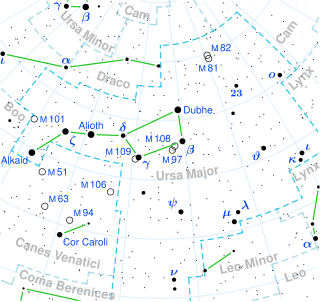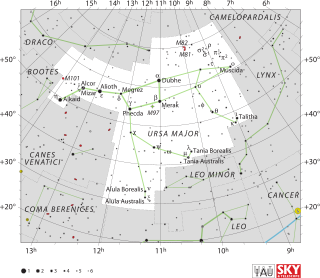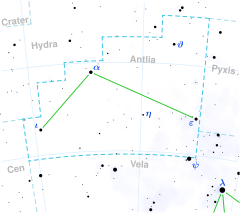
Omega Ursae Majoris is the Bayer designation for a binary star system in the northern circumpolar constellation of Ursa Major. It is visible to the naked eye with an apparent visual magnitude of 4.61. Based upon an annual parallax shift of 13.24 mas, it is roughly 246 light years from the Sun. At that distance, the visual magnitude of the star is diminished by an extinction factor of 0.11 due to interstellar dust.

Tau Ursae Majoris (τ UMa) is the Bayer designation for a binary star in the northern circumpolar constellation of Ursa Major. It is visible to the naked eye, having an apparent visual magnitude of 4.66. With an annual parallax shift of 25.82 mas, it is located about 126 light years from the Sun. At that distance, the visual magnitude is diminished by an extinction factor of 0.19 due to interstellar dust.

Delta Antliae is the Bayer designation for a binary star system in the southern constellation of Antlia. The combined apparent visual magnitude of the system is +5.57, allowing it to be viewed from the suburbs with the naked eye. Judging by the parallax shift of this system, it is located at a distance of 450 ± 10 light-years from Earth. The system is reduced in magnitude by 0.03 due to extinction caused by intervening gas and dust.
5 Aquarii is a single star in the zodiac constellation of Aquarius, located about 830 light years away from the Sun, based on parallax. 5 Aquarii is the Flamsteed designation. It is visible to the naked eye as a faint, blue-white hued star with an apparent visual magnitude of 5.55. This object is moving closer to the Earth with a heliocentric radial velocity of −3 km/s.
20 Aquarii, abbreviated 20 Aqr, is a star in the constellation Aquarius. 20 Aquarii is the Flamsteed designation. It is a dim star with an apparent visual magnitude of 6.38. Based upon an annual parallax shift of 15.34 mas, it is located 213 light years away but is moving closer to the Earth with a heliocentric radial velocity of −23 km/s. The star is predicted to come to within 110 light-years in around 1.9 million years.
Omicron Aurigae, Latinized from ο Aurigae, is the Bayer designation for an astrometric binary star system in the northern constellation of Auriga. With an apparent visual magnitude of 5.47, it is faintly visible to the naked eye. Based upon an annual parallax shift of 7.89 ± 0.84 mas, it is approximately 413 light-years distant from Earth. The star is a member of the Ursa Major stream of co-moving stars.

Pi Cassiopeiae, Latinized from π Cassiopeiae, is a close binary star system in the constellation Cassiopeia. It is visible to the naked eye with an apparent visual magnitude of +4.949. Based upon an annual parallax shift of 18.63 mas as seen from Earth, this system is located about 175 light years from the Sun.

4 Cassiopeiae is a red giant in the northern constellation of Cassiopeia, located approximately 790 light-years away from the Sun. It is visible to the naked eye as a faint, red-hued star with a baseline apparent visual magnitude of 4.96. At the distance of this system, its visual magnitude is diminished by an extinction of 0.56 due to interstellar dust. This system is moving closer to the Earth with a heliocentric radial velocity of −39 km/s.

Omega Cassiopeiae is a binary star system in the northern constellation of Cassiopeia. It has a combined apparent visual magnitude of +4.99, which means it is a faint star but visible to the naked eye. Based upon an annual parallax shift of 4.65 mas as seen from Earth, this system is located roughly 730 light years from the Sun. At that distance, the visual magnitude is diminished by an extinction of 0.16 due to interstellar dust.
3 Centauri is a triple star system in the southern constellation of Centaurus, located approximately 300 light years from the Sun. It is visible to the naked eye as a faint, blue-white hued star with a combined apparent visual magnitude of 4.32. As of 2017, the two visible components had an angular separation of 7.851″ along a position angle of 106°. The system has the Bayer designation k Centauri; 3 Centauri is the Flamsteed designation. It is a suspected eclipsing binary with a variable star designation V983 Centauri.
HD 7853 is a double star in the constellation Andromeda. With an apparent magnitude of 6.46, it can barely be seen with the naked eye even on the best of nights. The system is located approximately 130 parsecs (420 ly) distant, and the brighter star is an Am star, meaning that it has unusual metallic absorption lines. The spectral classification of kA5hF1mF2 means that it would have a spectral class of A5 if it were based solely on the calcium K line, F2 if based on the lines of other metals, and F1 if based on the hydrogen absorption lines. The two components are six arc-seconds apart and the secondary is three magnitudes fainter than the primary.
Beta Horologii, Latinized from β Horologii, is the third-brightest star in the southern constellation of Horologium. It is faintly visible to the naked eye with an apparent visual magnitude of 4.98. Based upon an annual parallax shift of 11.07 mas as seen from Earth, it is located about 295 light years from the Sun. The star is moving away with a radial velocity of +24 km/s.
4 Camelopardalis is a probable multiple star in the northern constellation of Camelopardalis, located 177 light years away from the Sun, based upon parallax. With a combined apparent visual magnitude of 5.29, it is visible to the naked eye as a faint, white-hued star. The pair have a relatively high proper motion, traversing the celestial sphere at an angular rate of 0.158″ per year. The system's proper motion makes it a candidate for membership in the IC 2391 supercluster. They are moving away from the Earth with a heliocentric radial velocity of 22.5 km/s.

Zeta1 Antliae is the Bayer designation for a binary star system in the southern constellation of Antlia. Based upon parallax measurements, the pair are located at a distance of roughly 350 light-years from Earth. They have apparent magnitudes of +6.20 and +7.01 and are separated by 8.042 arcseconds. The apparent magnitude of the combined system is +5.76, which is bright enough to be seen with the naked eye in suitably dark skies.

μ Ophiuchi, Latinized as Mu Ophiuchi, is a solitary, blue-white hued star in the equatorial constellation of Ophiuchus. It is visible to the naked as a faint point of light with an apparent visual magnitude of 4.62. This object is located approximately 760 light years away from the Sun based on parallax, but is drifting closer with a radial velocity of −18.5 km/s.

7 Sagittarii is a massive star in the southern zodiac constellation of Sagittarius which is located in the Lagoon Nebula, although multiple sources have considered it a foreground star. It is a dim star but visible to the naked eye with an apparent visual magnitude of 5.37. The distance to this star can be determined from the annual parallax shift of 3.02±0.28 mas, yielding a value of roughly 1,100 light years. It is moving closer to the Sun with a heliocentric radial velocity of −11 km/s.

Epsilon Pyxidis (ε Pyxidis) is quadruple star system in the southern constellation of Pyxis. It is faintly visible to the naked eye, having a combined apparent visual magnitude of +5.60. Based upon an annual parallax shift of 15.39 mas as seen from Earth, it is located around 212 light years from the Sun. The system is deemed to be a member of the Sirius supercluster of stars that share a common motion through space.

V518 Carinae is a naked-eye variable star in the constellation Carina. It is a member of the bright open cluster IC 2602 near the Carina Nebula.

Iota Mensae is a single star about 880 light years away in the faint constellation Mensa. It has a very slightly variable apparent magnitude of 6.0, making it visible with the naked eye under good skies.

2 Cassiopeiae is a white bright giant in the constellation Cassiopeia, about 2,800 light years away. It is a chemically peculiar Am star.












